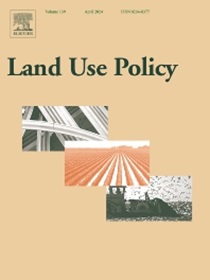农业发电增加了公众对在农业用地上生产太阳能的接受度
IF 6
1区 社会学
Q1 ENVIRONMENTAL STUDIES
引用次数: 0
摘要
土地竞争是脱碳能源转型的关键挑战。开放式太阳能农场越来越重要,但需要大量土地,并取代了农业生产。农业发电提供了一个折衷方案,将太阳能电池板集成到现有的农业操作中。然而,农业光伏的采用仍然有限,因为它比开放空间太阳能每公顷的能量输出更低,安装成本更高。在这里,我们比较了德国公众对农业发电和开放空间太阳能的态度,使用了来自全国代表性样本的实验数据。研究人员向参与者展示了三幅不同土地用途的景观图像,即没有太阳能的农田、农业光伏系统和开放空间太阳能系统,以及一些技术信息。虽然两种太阳能系统都对景观吸引力产生了负面影响,但对农业发电的负面影响较小。与常规电费相比,44% %的参与者表示愿意为农业光伏发电支付更多的费用,相比之下,29% %的参与者表示愿意为露天太阳能发电支付更多的费用。我们还发现,为农业发电买单的货币意愿更高。这些结果适用于不同的农业系统,这意味着农业发电可以在社会可接受的能源转换中发挥重要作用。更广泛地采用农业发电可能取决于有针对性的政策支持。本文章由计算机程序翻译,如有差异,请以英文原文为准。
Agrivoltaics increases public acceptance of solar energy production on agricultural land
Competition for land is a key challenge for decarbonized energy transitions. Open-space solar energy farms are gaining in importance but have large land requirements and displace agricultural production. Agrivoltaics offers a compromise, integrating solar panels into existing farming operations. However, adoption of Agrivoltaics remains limited, as it has lower energy output per hectare and higher installation costs than open-space solar. Here, we compare public attitudes towards Agrivoltaics and open-space solar in Germany, using experimental data from a nationally-representative sample. Participants were shown three images of a landscape that differed in terms of land use, namely an agricultural field without solar, an Agrivoltaics system, and an open-space solar system, together with some technical information. While both solar systems have perceived negative impacts on landscape attractiveness, the impacts are less negative for Agrivoltaics. In comparison to their regular electricity bill, 44 % of the participants expressed their willingness to pay more for electricity from Agrivoltaics, compared to 29 % for electricity from open-space solar. We also find a higher monetary willingness to pay for Agrivoltaics. These results hold across different agricultural systems, implying that Agrivoltaics could play an important role for socially-acceptable energy transitions. More widespread Agrivoltaics adoption may depend on targeted policy support.
求助全文
通过发布文献求助,成功后即可免费获取论文全文。
去求助
来源期刊

Land Use Policy
ENVIRONMENTAL STUDIES-
CiteScore
13.70
自引率
8.50%
发文量
553
期刊介绍:
Land Use Policy is an international and interdisciplinary journal concerned with the social, economic, political, legal, physical and planning aspects of urban and rural land use.
Land Use Policy examines issues in geography, agriculture, forestry, irrigation, environmental conservation, housing, urban development and transport in both developed and developing countries through major refereed articles and shorter viewpoint pieces.
 求助内容:
求助内容: 应助结果提醒方式:
应助结果提醒方式:


